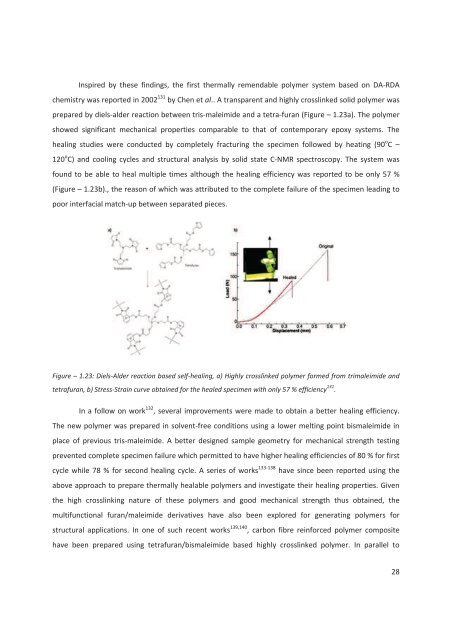4(%3)3 - Ecole nationale supérieure de chimie de Montpellier
4(%3)3 - Ecole nationale supérieure de chimie de Montpellier
4(%3)3 - Ecole nationale supérieure de chimie de Montpellier
You also want an ePaper? Increase the reach of your titles
YUMPU automatically turns print PDFs into web optimized ePapers that Google loves.
Inspired by these findings, the first thermally remendable polymer system based on DA-RDAchemistry was reported in 2002 131 by Chen et al.. A transparent and highly crosslinked solid polymer wasprepared by diels-al<strong>de</strong>r reaction between tris-maleimi<strong>de</strong> and a tetra-furan (Figure – 1.23a). The polymershowed significant mechanical properties comparable to that of contemporary epoxy systems. Thehealing studies were conducted by completely fracturing the specimen followed by heating (90 o C –120 o C) and cooling cycles and structural analysis by solid state C-NMR spectroscopy. The system wasfound to be able to heal multiple times although the healing efficiency was reported to be only 57 %(Figure – 1.23b)., the reason of which was attributed to the complete failure of the specimen leading topoor interfacial match-up between separated pieces.Figure – 1.23: Diels-Al<strong>de</strong>r reaction based self-healing, a) Highly crosslinked polymer formed from trimaleimi<strong>de</strong> andtetrafuran, b) Stress-Strain curve obtained for the healed specimen with only 57 % efficiency 131 .In a follow on work 132 , several improvements were ma<strong>de</strong> to obtain a better healing efficiency.The new polymer was prepared in solvent-free conditions using a lower melting point bismaleimi<strong>de</strong> inplace of previous tris-maleimi<strong>de</strong>. A better <strong>de</strong>signed sample geometry for mechanical strength testingprevented complete specimen failure which permitted to have higher healing efficiencies of 80 % for firstcycle while 78 % for second healing cycle. A series of works 133-138 have since been reported using theabove approach to prepare thermally healable polymers and investigate their healing properties. Giventhe high crosslinking nature of these polymers and good mechanical strength thus obtained, themultifunctional furan/maleimi<strong>de</strong> <strong>de</strong>rivatives have also been explored for generating polymers forstructural applications. In one of such recent works 139,140 , carbon fibre reinforced polymer compositehave been prepared using tetrafuran/bismaleimi<strong>de</strong> based highly crosslinked polymer. In parallel to28











